As HLB continues to devastate the citrus industry in Florida and beyond, IR-4 and stakeholders seek fresh solutions in emerging technologies.
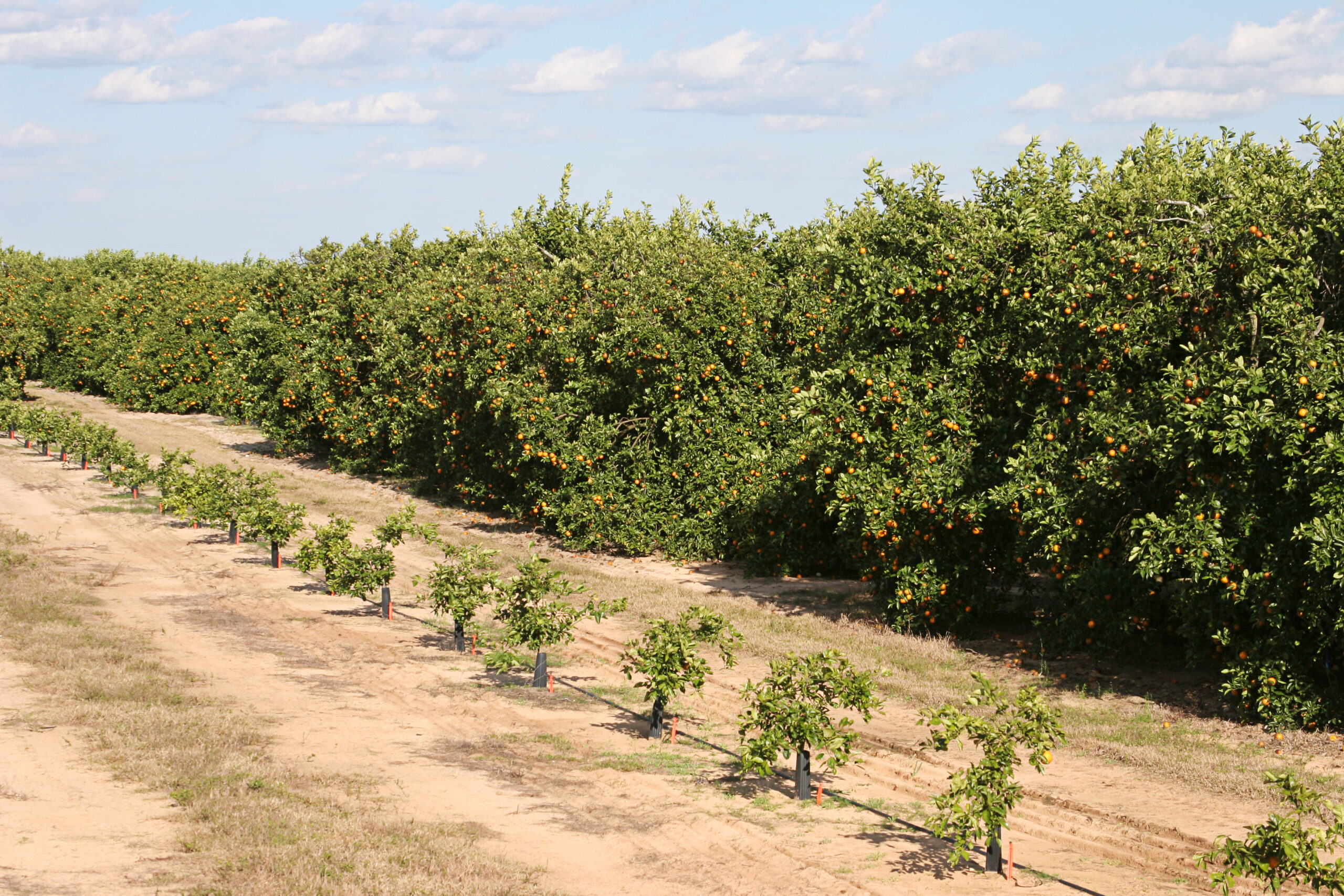
Stages of orange trees in a Florida grove. Image: Lisa F. Young / Adobe Stock.
Citrus greening (Huanglongbing or HLB) was first seen in Florida in 2005. In just 20 years, the disease has devastated the Florida citrus industry. The statistics tell the story: Florida has experienced a 90% loss of production from about 300 million boxes in 2004 to 20 million boxes in 2024 (14.1 are forecasted for 2025); more than double the production cost; 50 million trees lost; 33,000 jobs gone; and $20 billion in lost revenue. Not to mention the devastation of rural economies.
It is important to note that citrus greening is not entirely responsible for the decline in production. Multiple hurricanes, freezes, declining consumer consumption of orange juice, and last but not least—increasing population pressure and the associated demand for more housing developments—also play a part. However, experts agree that citrus greening is responsible for a large amount of the decline and is the most immediate threat to the citrus industry.
HLB has spread to every citrus-growing state, and the U.S. has gone from a positive to a negative trade balance regarding citrus imports and exports. Until 2014, exports were 18 million boxes more than imports, but in 2022, the U.S. imported 22 million boxes more than it exported. Despite tremendous efforts by scientists in those 20 years, there still is no cure, or even a management solution that has made a significant impact.
That doesn’t mean researchers have given up—far from it. New scientific technologies, such as CRISPR, and a better understanding of how to enhance a tree’s own defenses offer promise. Three of these emerging solutions have U.S. Department of Agriculture (USDA) approval and are awaiting the go-ahead from the U.S. Environmental Protection Agency (EPA). These biological solutions have been developed by a combination of private companies and universities, and IR-4 has been integral to the development and approval process.
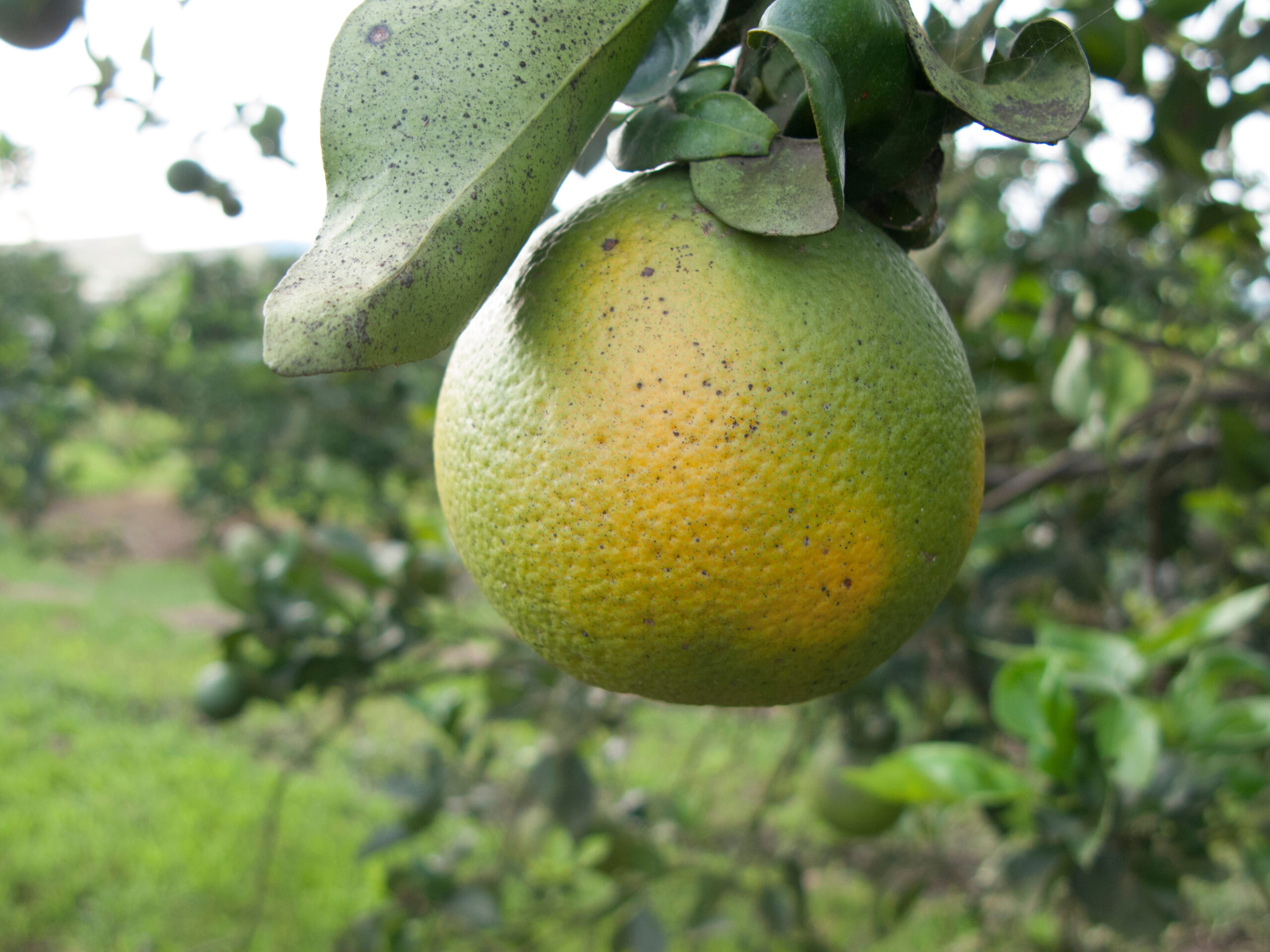
Huanglongbing (citrus greening) is devastating the citrus industry in Florida and beyond,
with no current control options. Image: Ellen/Adobe Stock.
The Role of IR-4
“IR-4 essentially acts as an agent, working with the government agency or small business to conduct the studies they need,” says Bill Barney, Biopesticide Regulatory Support Manager for IR-4. “We have great relationships with regulatory agencies like the EPA and USDA and are able to help facilitate the registration process, helping the parties involved to meet guideline requirements.”
IR-4 was established in 1963 by the USDA and the land-grant universities to help farmers of fruit, vegetables, nuts, herbs, ornamentals, and other specialty crops to gain legal access to safe and effective pest management products. In 2015, IR-4 established the Biopesticide Regulatory Support Program to focus on the increasing demand for biological controls, both for organic farmers and to mitigate residues of conventional pesticides, Barney says.
HLB is caused by a bacterium, Candidatus Liberibacter asiaticus (CLas), which is carried by the Asian citrus psyllid, a tiny gnat-sized insect. When the psyllid feeds on an infected tree, it becomes a carrier of the bacteria, which the insect then injects into the next tree it feeds on. While the feeding itself damages the leaves, the major issue is the bacterium multiplying and clogging the phloem, part of the vascular system that carries nutrients and sugars throughout the plant. Leaves turn yellow and drop, first on individual branches and then continue to spread. Eventually, the entire tree dies—sometimes in less than five years, depending on its size. During this process, the tree becomes less productive with fewer, smaller fruits that often drop before they ripen. The juice is bitter, and often the rind remains partially green, which gives rise to the common name of the disease (citrus greening).
IR-4 is currently involved in three projects related to HLB, all of which fall under the purview of the Biopesticide Regulatory Support Program, as they involve biological products rather than conventional chemistries.
Helping Citrus Trees Help Themselves — with the Help of Other Plants
“All three of the citrus greening projects we’ve worked on have a mode of action where they are making the tree more resistant to the disease—they stimulate the plant’s defense system. There isn’t a direct killing action on the disease itself,” says Michael Braverman, who was the manager of IR-4’s Biopesticide Regulatory Support Program for 25 years and is now retired.
One project incorporates antimicrobial peptides from spinach, called defensins, which provide a natural defense against a wide variety of pathogens. Because defensins are from a commonly eaten food (spinach), they have a long history of safe use in human and animal consumption. Researchers at Texas A&M University developed a way to deliver the peptides to citrus trees using a harmless virus developed at the University of Florida. Budwood from trees “infected” by the virus is grafted onto trees affected by HLB, and the virus (along with the defensin peptides) targets the HLB-infected sites.
“While spinach is not susceptible to citrus greening, when the defensin peptides are inserted into a citrus tree, it becomes more resistant to disease and reduces symptoms,” Braverman says.
The researchers observed the treated trees over several years and documented up to 50% increases in fruit yield compared to untreated controls after just one application. Texas A&M University and Silvec Biologics are working with IR-4 to get regulatory approval and hope to commercialize the budwood for use in treating HLB-infected trees and to protect those not yet infected. The notice of filing and request for comments for this project was published in the Federal Register on July 3, 2025.
Braverman says a somewhat similar project, also using spinach defensins but in mature budwood, is underway and nearing the EPA submission process, but is not yet completed. It is being developed by the University of Florida and is also being facilitated by IR-4.
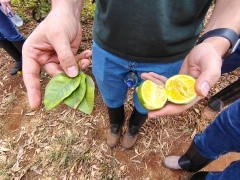 |
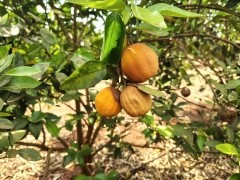 |
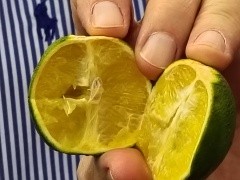 |
Citrus greening damage captured by IR-4 Biopesticide Regulatory Manager, Bill Barney.
An Alternative Approach: Deleting Susceptible Genes
Another project that IR-4 has helped shepherd into EPA submission involves CRISPR technology and the creation of an HLB-resistant rootstock. CRISPR is a game-changing gene editing technology that allows modification of DNA sequences. In this instance, scientists set out to remove the gene sequence that makes citrus trees susceptible to the HLB bacteria. These genes were identified after years of painstaking research by Nian Wang at the University of Florida.
“Because the process mimics the natural evolution of plants through natural selection, it is classified as non-GMO by the USDA,” Braverman says.
To test their results, the CRISPR-edited plants were grafted to HLB-infected trees along with unedited control plants, with the happy result that the edited plants did not become infected while the control plants did. This development is in the early stages, but a trial of 400 trees showed a nearly 17,000 times reduction in CLas, the bacteria that causes HLB—enough promise that Soilcea, the company that developed the protocol for using CRISPR to edit the HLB-susceptible genes, has applied for EPA approval. The company has received funding from the USDA’s HLB Multi-Agency Coordinating Group and the Emergency Citrus Diseases Research and Extension. If approval is received, Braverman says it will take about five years to scale up production of the rootstock and obtain a fruit-bearing tree. The notice of filing and request for comments for this project was published in the Federal Register on July 3, 2025.
Comparing Apples to Oranges Has Positive Results
Apples seemingly have nothing in common with citrus trees; they are grown in more northern areas of the U.S. under vastly different environmental conditions and are in no way related to citrus. But they are susceptible to fire blight, which can kill entire branches or even a whole tree in just one season. Like HLB, fire blight is caused by a bacterium, Erwinia amylovora. USDA-funded research at the University of Wisconsin, led by Ching-Hong Yang, showed that a beneficial soil bacterium called Pseudomonas soli is highly effective at controlling fire blight—and, importantly for citrus growers— HLB and citrus canker (Xanthomonas axonopodis pv. citri and X. a. pv. aurantifolii) as well.
In particular, the T307 strain of P. soli produces a natural compound, RejuAgro A (RAA), that has anti-bacterial effects on these pathogens. RAA levels can fluctuate due to environmental conditions, so scientists found natural RAA inducers that consistently boost RAA production. By blending these inducers with the T307 strain of P. soli, they have developed a sprayable biocontrol product called Reju Agro.
Braverman says it offers a better alternative than the antibiotic sprays that are currently used. “Some of those work very well for a time, but the bacteria can develop resistance,” he says. “In this case, the product induces a natural defense response within the plant, making development of resistance less likely.”
Results on fire-blight-inoculated apple trees with P. soli T307 alone reduced blossom blight infection from 92% (untreated control) to 65%. The addition of the RAA inducers in the form of Reju Agro further reduced infection rates to 25%.
Dr. Yang recently received $1.5 million to continue his research, this time evaluating the efficacy of trunk injections of Reju Agro in citrus trees, with the specific goal of combating HLB. Research is expected to be completed at the end of 2027. IR-4 has provided EPA registration support for this active ingredient.
All of these biological efforts are important because, as Kristen Searer-Jones, Regional Field Coordinator for IR-4’s Southern Region, says, “There’s not much in the pipeline for citrus greening on the conventional side of things.”
Searer-Jones grew up in Florida and has seen the decline of the citrus industry firsthand. “Seeing groves turn into housing developments, or even if they are still there, they are just skeletal trees, is really sad,” she says. “IR-4 Executive Director Jerry Baron and I toured a facility in March where massive production and processing buildings and office buildings were just empty. It was like a ghost town. All those jobs just went away.” However, citrus is still a $7 billion industry in Florida, supporting more than 30,000 jobs, and is vital to the state’s economy.
Like Barney and Braverman, Searer-Jones says there isn’t a silver bullet right now, but solutions that can get citrus back to profitable production levels would be considered a win. Florida Commissioner of Agriculture Wilton Simpson has been quoted as saying that increasing production to 50–70 million boxes per year in the next 10 years could be considered a success.
While these emerging biological tools represent a positive trend towards diversifying growers’ pest management toolkits, many growers want to see conventional tools become available to manage citrus greening. Particularly in a climate like Florida’s, where pest pressure is persistent, the efficacy of conventional tools is important to growers. With HLB, the crop protection industry has the difficult task of trying to create solutions to fill the void, and there aren’t currently any conventional options available, outside of insecticide products that reduce the Citrus psyllid that transmits the HLB.
IR-4 is committed to exploring tools that run the gamut from biological to technological to conventional as new options emerge from our industry partners. Diverse approaches are needed to give growers the best chance at salvaging their citrus production, not only in Florida but in California and other citrus-producing states. The good news is that IR-4 has a deeply engaged network of industry representatives, growers, and researchers; together, this network has the expertise to evaluate new tools, push them through the regulatory process, and get them in the hands of growers.
Time is of the essence for growers losing more and more of their citrus production capacity, and Searer-Jones stresses that IR-4 is committed to helping growers. “We want to get the word out to citrus growers and the industry at large that we are here; we have resources and a team to help facilitate ideas to help combat HLB. Our team has a wide array of backgrounds and education. Bring us your ideas and we will figure out if there is a way for us to make that research happen—that’s what we are here for.”
Submitting Project Requests to IR-4
Stakeholders are encouraged to submit Project Clearance Requests that explore potential new options to manage citrus greening. Sign up for the newsletter to stay informed about IR-4’s research, events, submission deadlines, and more. Questions may be directed to IR-4 Headquarters at ir-4_project@ncsu.edu.
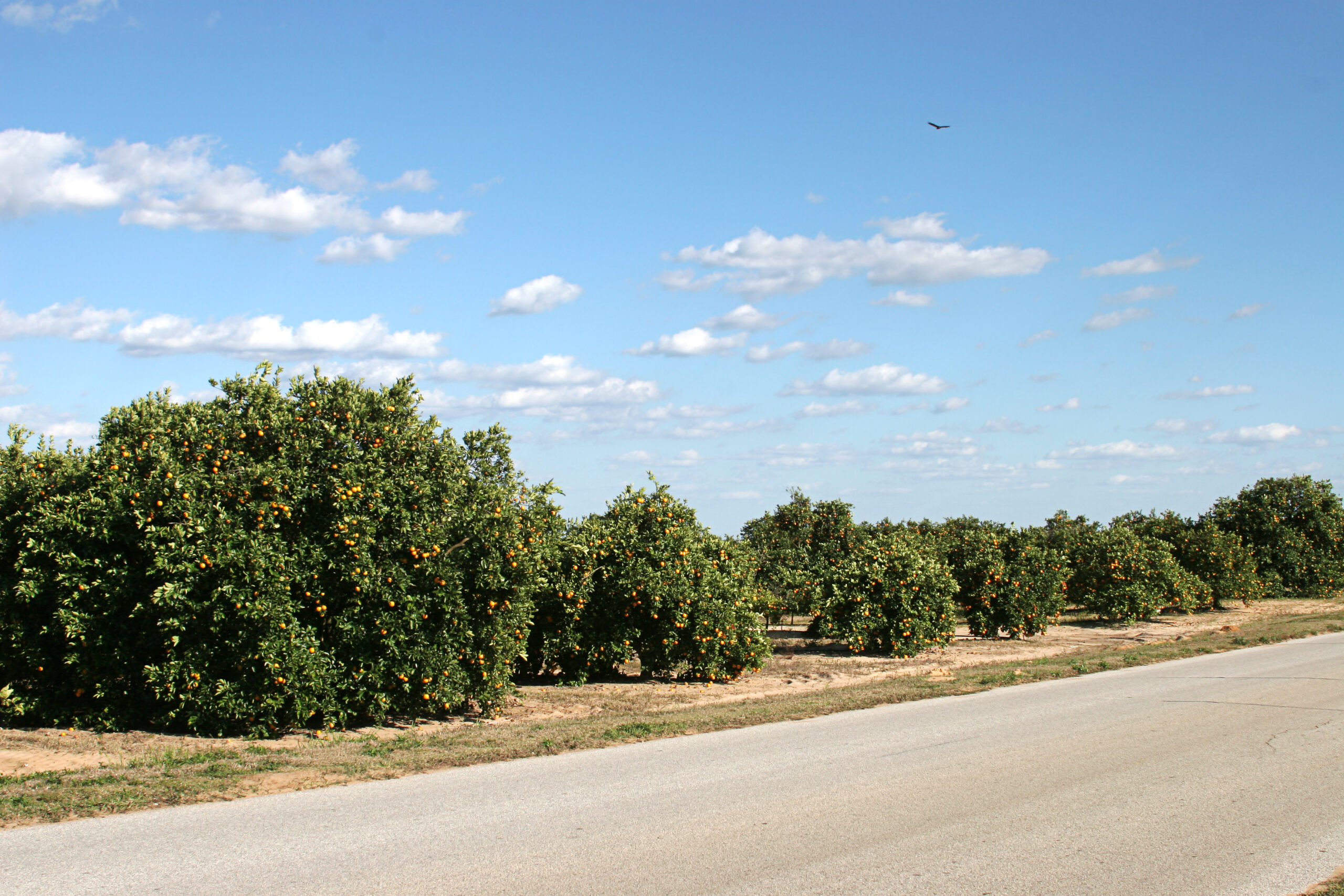
IR-4 invites stakeholders to collaborate in support of a healthy citrus industry. Image: Lisa F. Young / Adobe Stock.
References
CFMGDev, and CFMGDev. “Soilcea’s Disease-Resistant Sweet Orange Trials Report Promising Results.” Central Florida Ag News, 5 Mar. 2025, centralfloridaagnews.com/soilceas-disease-resistant-sweet-orange-trials-report-promising-results.
Cooper, Daniel. “How Florida Orange Production Plummeted 92% in 20 Years.” Citrus Industry Magazine, 7 May 2024, citrusindustry.net/2024/05/07/florida-orange-production-plummeted-years.
“Trunk-Injection Biopesticide for HLB – HLB Management Citrus Industry Magazine.” Citrus Industry Magazine, 16 May 2025, citrusindustry.net/2025/05/16/trunk-injection-biopesticide-hlb.
Hopkins, Matt. “Silvec Biologics Announces New Solution for Citrus Greening Disease Progresses to EPA Full Science Review.”AgriBusiness Global, 19 Aug. 2024, www.agribusinessglobal.com/agrochemicals/fungicides/silvec-biologics-announces-new-solution-for-citrus-greening-disease-progresses-to-epa-full-science-review.
Researchers Find New Defense Against Hard-To-Treat Plant Diseases. 8 May 2025, stories.tamu.edu/news/2025/05/08/researchers-find-new-defense-against-hard-t0-treat-plant-diseases.
Revolutionizing Organic Fire Blight Management: Harnessing the Power of Novel Biocontrol Bacterium Pseudomonas Soli T307. University Of Wisconsin System. portal.nifa.usda.gov/web/crisprojectpages/1031313-revolutionizing-organic-fire-blight-management-harnessing-the-power-of-novel-biocontrol-bacterium-pseudomonas-soli-t307.html#:~:text=We%20have%20identified%20a%20potential,amylovora.
Soilcea. soilcea.com.
“U.S. Citrus Production – an Uphill Battle to Survive.” American Farm Bureau Federation, www.fb.org/market-intel/u-s-citrus-production-an-uphill-battle-to-survive.
